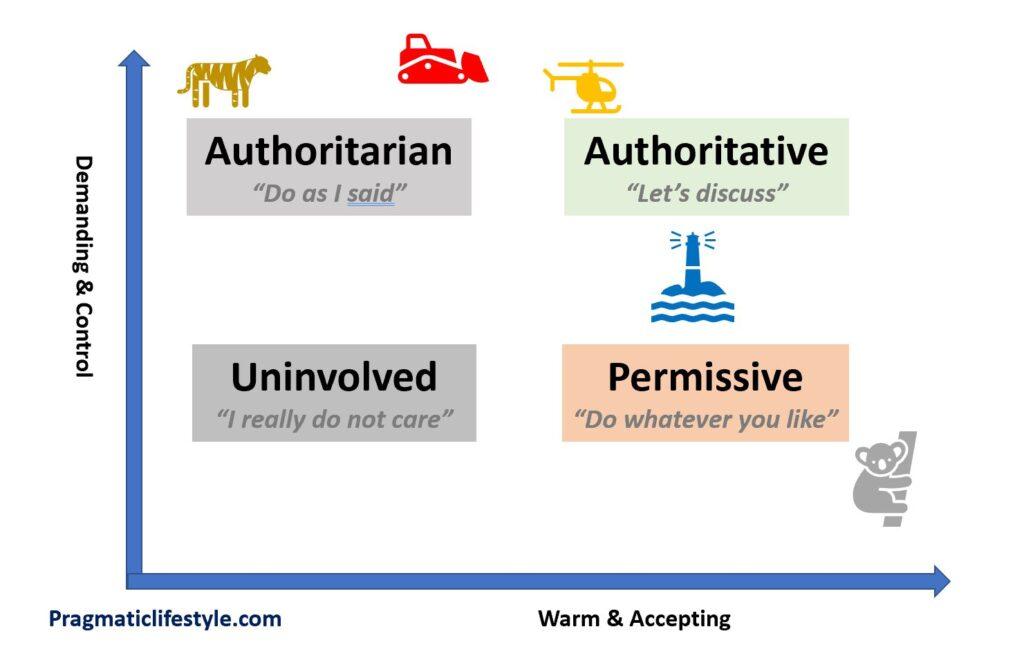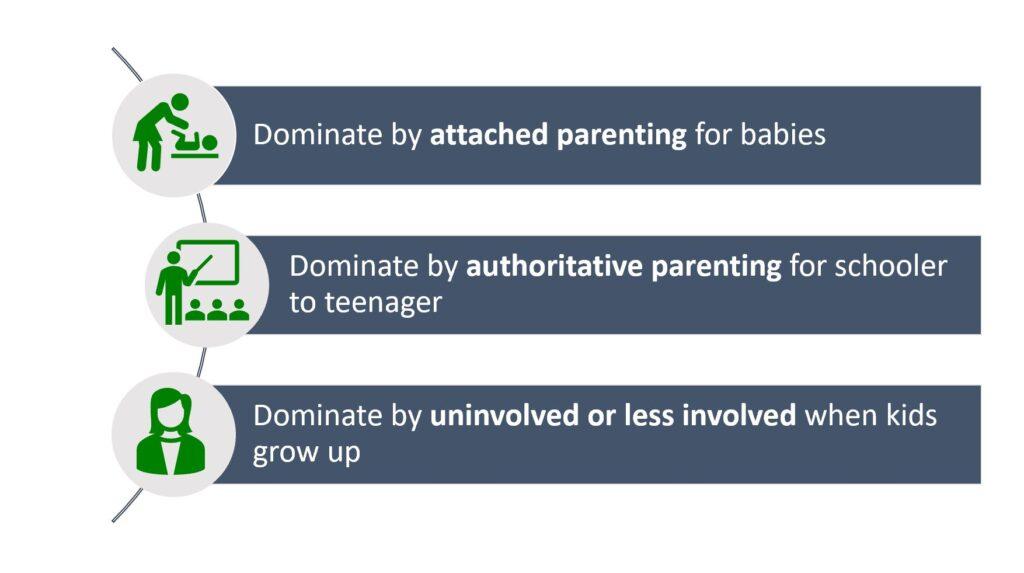You’ve observed various parenting styles while attending playdates, birthday parties, or strolling around the playground. Today we are going to discuss the four main parenting categories and six different parenting styles. Moreover, we are going to discuss the impact factors for your parenting styles. You may find out the reason of why you choose a certain parenting style.
Related Reading:
- 12 Things can Help Raise Kids with Diversity and Inclusion in Mind
- 10 Ways to Be an Upstanders in Bullying
Table of Contents
4 Main Parenting Categories
Each parenting style uniquely impacts children’s behavior and can be distinguished by specific characteristics. Psychologist Diana Baumrind classified children into three types: parental demandingness (the control parents exert over their children to influence their behavior) and responsiveness (parents are warm and sensitive to their children’s needs). Other researchers later added a fourth style, neglectful.
Authoritarian parenting emphasizes strict rules, obedience, and discipline. These parents have high expectations and are not afraid to punish their children if they do not follow their rules. Authoritarian parents also dominate decision-making, rarely allowing their children to participate.
Permissive parents behave more like friends than authorities. They meet their children’s needs without imposing many disciplines. Permissive parents are relax and lenient, with few household rules. These parents are the antithesis of strict.
Authoritarian parents set limits for their children while allowing them to make their own decisions. They see mistakes as a learning opportunities and set high standards for their children. Authoritarian parents are nurturing and warm, but they also emphasize the value of responsibility and discipline.
Negligent or uninvolved parents neglect their children, leaving them to raise themselves. They do not establish rules or expectations and do not provide guidance when required.

6 Sub-Types of Parenting Styles
Free-range parents are also neglectful, less supervising their children, and could endanger kids’ safety.
Helicopter or overprotective parents try to help in most aspects of their children’s lives. They constantly intervene and obsess over their children’s successes and failures with good intentions. Fear and anxiety often drive helicopter parents’ risk-taking tendencies. Parents intervening in this manner may jeopardize their child’s ability to learn critical life skills, confidence, and self-sufficiency.
Related Reading:
- 5 Unspoken Dangers of Helicopter and Overprotective Parents
- A Parent Conflict After Kids Changed Pokémon Card
Snowplow parents are willing to do everything to meet their children’s needs by “plowing down” anything that gets in the way of their children. Like helicopter parents, snowplow parents have good intentions and do not want their children to struggle. However, these habits do not lay the groundwork for long-term happiness and can exacerbate a child’s fear of failure.
Lighthouse parents try to be the role models for their children but also keep an eye on the rocks to ensure kids don’t collide. They look into the water, prepare for kids to ride the waves, and believe in their learning ability.” This entails striking the ideal balance between loving, protecting, communicating with, and nurturing your child.
Attachment parents advocate a nurturing and hands-on approach to parenting. They believe prioritizing a child’s needs leads to independence and emotional stability. Attachment parents are also value physical closeness, bed-sharing and co-sleeping, extended breastfeeding, positive discipline, and other attachment-based approaches.
Tiger parenting, often rigid and harsh, sets high expectations and expects obedience and success. Amy Chua’s book, Battle Hymn of the Tiger Mom, popularized the term by describing tiger parenting as an authoritarian method standard in Chinese culture.

Impact Factors for Parenting Style
From my observation, many families are mix parenting styles. For example, my father is more authoritative, and my mother is more attached. In most cases, they are well blended. When I was young, attachment parenting was dominant; in the teenage stage, authoritarian parenting was in charge due to teenage rebellion and middle-life crisis. More extreme, one specific aspect is never relaxed, sleeping outside without adult supervision. Travel alone? No! Sleepover? No!
1. Parenting Goals and Vision:
Like running a company, parenting goals can influence the way they interact with children. For example, some parents prioritize the academic achievement while others may prioritize the creativity. Some of them already think about what kind of career their kids will take. However, the world changing too fast than our imagination, we cannot really plan a career for our kids. Then what does parenting goal means? In my opinion, the following three questions can help you.
- What characteristic do you wish your kids have to along with their life? (name 3 characteristics)
- Imaging your relationship with your child when they are teenagers.
- Do you have an ideal parenting relationship that you see or experience in your relationship?

2. The Age of Kids and Birth Sequence
Related Reading:
- 12 Suggestions for Parenting Adult Children
- 6 Facts About Teen Friendship and How Parents Can Support Them
- 6 Tips To Help Parents Talk with Teens about Friendship
- What Should Parents Do? A Story about Kids Lie and Sibling Fight
- 8 Youngest Child Traits: Does Birth Order Matter?
- 5 Playful Ideas To Encourage Your Toddler Talk With You
- Positive Discipline – How to Get Your Toddler to Listen Without Yelling
Age of Kids
Kids have different developmental stages and milestones require different levels of support, guidance, and discipline from parents. For example, babies require a lot of physical care and attention, such as feeding, changing, and soothing. Parents need to be more responsive to their kids’ needs, e.g. more attachment to provide comfort and safety.
As kids grow to toddlers, parents need to set appropriate boundaries while allowing kids to explore and learn their own sense of autonomy and independence. Parents can use positive reinforcement and other strategies to encourage positive behavior.
After kids enter school, they may need more guidance in academics, social skills, and emotional regulation, that parents can be more involved in their child’s education and social development, while still allowing their child to take on increasing levels of responsibility.
As children move into adolescence and beyond, they may require more independence and autonomy, while still needing support and guidance from their parents. Parents may need to be more flexible and open to negotiation while still maintaining appropriate boundaries and expectations.

Birth Sequence
Similarly, parenting styles can differ from one child to the next; for example, many parents are more authoritarian with their first child but more attached to their last child, as parents have different expectations and approaches for their first-born child compared to their younger siblings. Research suggests that birth order can shape children’s personality traits and behaviors, which may in turn affect the way parents interact with them. For example, first-time parents may be more protective and cautious, while parents of multiple children may be more relaxed and flexible.
For example, first-born children are often seen as more responsible, achievement-oriented, and conforming, while younger siblings may be more rebellious, creative, and outgoing. Parents may respond to these differences in ways that reinforce or shape their children’s personalities.

3. The Energy Level of Parents
When parents have time and energy, they tend to be authoritative; when parents are tired and busy, they tend to be uninvolved.
Parenting can be physically and emotionally demanding, and a parent’s level of energy can affect their ability to engage in positive interactions with their child, set appropriate limits and boundaries, and respond to their child’s needs.
For example, a parent who is feeling tired or stressed may be less patient and more likely to be authoritarian or uninvolved, while a parent who is feeling energized and positive may be more likely to authoritarian and engage in playful interactions with their child. A parent’s energy level can also impact their ability to provide consistent and responsive care. If a parent is feeling overwhelmed or depleted, they may be less able to provide the level of attention and support that their child needs.
Related Reading:
- 12 Jobs That Benefit Both Motherhood and Career in 2022
- Top 10 High Paid Jobs for Women Career Consideration [2022]
- Gifted Child in Family, the Effort Behind the Blessing

4. Culture and Socioeconomic Status (SES)
Culture
Different cultures have different beliefs, values, and norms about child-rearing, which can shape the way parents interact with their children. For example, some cultures place a strong emphasis on obedience and respect for authority, while others prioritize independence and self-expression. These cultural values can impact the way parents discipline their children, the types of behaviors they reinforce or discourage, and the level of autonomy and decision-making power they give their children. Gender roles and family structure can also impact parenting style. e.g., in some cultures, fathers may be expected to play a more distant or authoritarian role in parenting, while mothers may be expected to provide more nurturing and emotional support. These cultural expectations can impact the division of labor and responsibility within the family, as well as the way parents interact with their children.

Socioeconomic status
Family’s socioeconomic status (SES) can also have an impact on parenting style. SES refers to a family’s income, education level, and occupation. The socioeconomic status can impact the families’ access to resources, stress, education etc. For example, parents who are struggling to meet basic needs may have less time and energy to devote to their children, while parents who have access to resources and support may be better able to provide for their children’s needs and engage in positive interactions.
- Access to Resources: Families with higher SES may have more access to resources, such as high-quality child care, educational materials, and extracurricular activities. These resources can support parents in providing a stimulating and enriching environment for their children.
- Parenting Goals: Parents with lower SES may place more emphasis on obedience and conformity, while parents with higher SES may prioritize creativity, independence, critical thinking skills, and communication styles.
- Parental Stress: Parents with lower SES may experience more stress due to financial hardship, job insecurity, and other factors, which can lead to increased frustration, fatigue, and other negative emotions. This can impact parenting behaviors such as emotional responsiveness, consistency, and positive reinforcement. For example, the authoritative style intends to help the parent raise an independent, self-reliant, and responsible child.

5. The Way Parents were Rewarded
Parents may model their own parenting practices on the experiences and values they learned from their own parents, either by replicating those practices or by reacting against them. For example, parents who were raised in households where they were frequently praised and rewarded for their achievements may be more likely to use positive reinforcement and praise with their own children, while parents who experienced harsh punishment or criticism may be more likely to use negative reinforcement or punishment with their children. According to Kohn (1977), parents emphasize qualities necessary for survival. Working-class people are not rewarded by independent or questioning management; instead, they get promoted if they arrive on time, do their work as instructed, and can be reliable. As a result, these parents reward their children’s honesty, dependability, and obedience. Professionals from the middle class are rewarded for taking the initiative, being self-directed, and being assertive in their jobs. They are expected to be creative and work independently. These parents model those qualities for their children by rewarding independence and self-reliance.

Related Reading:
- 10 Benefits and Challenges of Theatre Lessons for Kids (Age 5-12)
- 9 Ways to Building Passive Income for Stay at Home Parents
- Live in a RV and Travel with 3 Kids
- Raise a Child in the U.S. and Netherlands in 2022 – the Average Cost Comparison ($300k vs $100k)
- 15 Ways of Earn Money as Stay-at-Home Parent
- 3 Criteria to Choose Extracurricular Activities For Young Schoolers
- 10 Best Extracurricular Activities For Young Schoolers
- The Cost Overview of Learning Music
- How to Talk About Money to Your Kids
- The Cost of Diapers from 0 to 3 Years Old Child
Final Thoughts from Pragmatic Lifestyle
While authoritative parenting receives the most praise from experts, it is important to note that it does not guarantee positive outcomes.
Parenting is an art, not a science. It’s important to note that while the experiences and values of parents’ own upbringing can have an impact on their parenting practices, parents also have the ability to reflect on and adjust their own parenting practices based on their own values and experiences, as well as new information and resources. Ultimately, parents have the opportunity to create their own unique parenting style that reflects their own values, goals, and strengths, while also being responsive to the changing needs and abilities of their children. Be encouraging and attentive to your child. Allow them to participate in decision-making so that they can grow and learn on their own.
About Me
Hi, there. I am Lin. Together with my husband and two kids, we live in the beautiful Netherlands in Europe. I am dedicated to self-development, creating quality time for the whole family, and fully supporting kids with their potentials and possibilities with all I have learned from engineering, MBA, and 10+ years of working experience in the energy sector.


